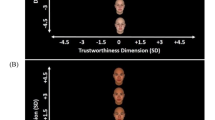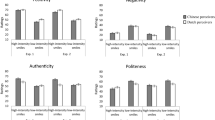Abstract
Several studies have already documented how Americans and Japanese differ in both the expression and perception of facial expressions of emotion in general, and of smiles in particular. These cultural differences can be linked to differences in cultural display and decoding rules (Ekman, 1972; and Buck, 1984, respectively). The existence of these types of rules suggests that people of different cultures may hold different assumptions about social-personality characteristics, on the basis of smiling versus non-smiling faces. We suggest that Americans have come to associate more positive characteristics to smiling faces than do the Japanese. We tested this possibility by presenting American and Japanese judges with smiles or neutral faces (i.e., faces with no muscle movement) depicted by both Caucasian and Japanese male and female posers. The judges made scalar ratings of each face they viewed on four different dimensions. The findings did indicate that Americans and Japanese differed in their judgments, but not on all dimensions.
Similar content being viewed by others
References
Buck, R. (1984).The communication of emotion. New York: Guilford.
Condon, J. (1984).With respect to the Japanese. Vershire, VT: Intercultural Press.
Condon, J., & Saito, M. (1974).Intercultural encounters with Japan. Tokyo: Simul Press.
De Mente, B. (1990).The kata factor. Phoenix, AZ: Phoenix Book Publishers.
Ekman, P. (1972). Universals and cultural differences in facial expressions of emotion. In J. Cole (Ed.),Nebraska Symposium of Motivation, 1971 (Vol. 19, pp. 207–283). Lincoln: University of Nebraska, Press.
Ekman, P. (1978). Facial signs: Facts, fantasies, and possibilities. In T. Sebeok (Ed.),Sight, sound. and sense (pp. 124–156). Bloomington: Indiana University Press.
Ekman, P. (1985).Telling lies. New York: Norton.
Ekman, P., Davidson, R., & Friesen, W. V. (1990). Emotional expression and brain physiology, II: The Duchenne smileJournal of Personality and Social Psychology, 58, 342–353.
Ekman, P., & Friesen, W. V. (1975).Unmasking the face. Englewood Cliffs, NJ: Prentice-Hall.
Ekman, P., & Friesen, W. V. (1978).Facial Action Coding Systems (FACS): A technique for the measurement of facial action. Palo Alto, Ca.: Consulting Psychologists Press.
Ekman, P., & Friesen, W. V. (1982). Felt, false, and miserable smiles.Journal of Nonverbal Behavior, 6, 238–252.
Ekman, P., Friesen, W. V., O'Sullivan, M., Chan, A., Diacoyanni-Tarlatzia, I., Heider, K., Krause, R., LeCompte, W., Pitcairn, T., Ricci-Bitti, P., Scherer, K., Tomita, M., & Tzavaras, A. (1987). Universals and cultural differences in the judgments of facial expressions of emotion.Journal of Personality and Social Psychology, 53, 712–717.
Friesen, W. V. (1972).Cultural differences in facial expressions in a social situation: An experimental test of the concept of display rules. Unpublished doctoral dissertation, University of California, San Francisco.
Keppel, G. (1982).Design and analysis: A researcher's handbook. Englewood Cliffs, NJ: Prentice-Hall.
Matsumoto, D. (1990). Cultural similarities and differences in display rules.Motivation and Emotion, 14, 195–214.
Matsumoto, D., & Ekman, P. (1989). American-Japanese cultural differences in judgments of facial expressions of emotion.Motivation and Emotion, 13, 143–157.
Matsumoto, D., Wallbott, H., & Scherer, K. (1989). Emotions in intercultural communication. In M. Asante and W. Gudykunst (Eds.),Handbook of International and Intercultural Communication (pp. 225–246). Beverly Hills: Sage.
Maxwell, S. E., & Delaney, H. D. (1992).Designing experiments and analyzina data. Belmont, CA: Wadsworth Publishing Co.
Author information
Authors and Affiliations
Additional information
David Matsumoto was supported in part by a research grant from the National Institute of Mental Health (MH 42749-01), and from a Faculty Award for Creativity, Scholarship, and Research from San Francisco State University. We would like to thank Masami Kobayashi, Fazilet Kasri, Deborah Krupp, Bill Roberts, and Michelle Weissman for their aid in our research program on emotion. We would especially like to thank the Editor for her excellent suggestions and help in conceptualizing this research.
Rights and permissions
About this article
Cite this article
Matsumoto, D., Kudoh, T. American-Japanese cultural differences in attributions of personality based on smiles. J Nonverbal Behav 17, 231–243 (1993). https://doi.org/10.1007/BF00987239
Issue Date:
DOI: https://doi.org/10.1007/BF00987239




